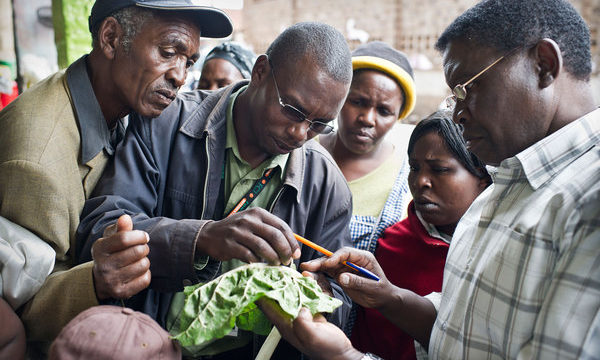
The African shrub Guiera senegalensis (© Marco Schmidt)
Improving food production in drought-prone, insecure areas of West Africa is a major challenge and concern for governments and their respective communities. A new crop management system incorporating the promotion of perennial shrubs may be a key potential solution to such problems.
Native shrubs have persisted throughout the toughest of climates and growing conditions, and by using such plants to our advantage, farmers may be able to improve crop production by more than 900% in some areas. A recent study lead by Richard Dick, published in the journal Frontiers in Environmental Science states that when planting the shrub Guiera senegalensis adjacent to millet, water is shared out between the plants in the soil. Thus improving the productivity of crops growing in drought conditions.
“People in West Africa rely on locally grown crops to survive. Finding ways to increase food production, especially during times of severe drought is critical.” said Richard Dick in ScienceDaily. “As things stand now, the population is continuing to climb, there’s no more land and yields are staying flat.”
Rural farmers in Senegal have been promoting the growth of woody shrubs such as G. senegalensis for hundreds of years. However, in other areas of West Africa, many perceive the plant as a problem and actively uproot and burn them. By taking the historical practices and knowledge from the farmers and communities who have integrated shrub growth into their daily farming practices, Richard and his team have developed a novel crop management system called ‘optimized shrub system’ to take advantage of this natural by-product of shrub development. By dramatically increasing shrub densities across field sites (from 300 shrubs per hectare to 1500 per hectare) the system resulted in dramatic increases in crop yields, improved soil quality and nutrient concentrations, as well as reduced the time to harvest by up to 15 days.

Wild G. senegalensis in Niger (© Nicolas Barbier)
The cause of this increased water availability was actually found to be due to the roots of the shrubs. As they grew deeper into the soil to reach groundwater, which equips them for survival in arid environments, the water leaks into the surrounding upper levels of the soil which is then used by crops. Leakage of water only occurs at night when the stomata pores in the roots are closed.
“We proved that ‘bio-irrigation’ by these shrubs is happening and it’s the first time this has been shown for crop production,” said Dick. “This is a native plant and it’s free and easy to grow, everything about this is positive.”
The next stage is to continue with pilot testing in fields with the growing systems with farmers throughout the Sahel to make any needed alterations to the methodology to improve the likelihood of successful implementation across Africa. Finding natural solutions to help feed a growing population is becoming increasingly important. In other areas across the world, such as Southeast Asia and South America, farmers are adapting to population growth through the use of fertilizers and pesticides. However, in countries such as Senegal, growers generally do not use such chemicals and do not have the resources to manage land similarly to other parts of the world.
“The ultimate solution is going to be whatever is locally available, and finding these answers and working with the local farmer to consider potential agricultural techniques is paramount,” said Richard Dick.
If you would like to read further on this subject, please see the links below:
2 Comments
Leave a Reply
Related News & Blogs
Improving water storage capacity in low-quality soils in sub-Saharan Africa
In drought-prone areas, efficient water storage is crucial to support crop productions, however poor quality soils often hinder efforts. SWRT technology has been developed to combat these environmental issues and improve global crop production and farm…
15 November 2019


[…] Fighting hunger in West Africa with shrubs […]
Guiera Senegalensis is an emblematic tree of our west african ecosystem here. In the Bambara religion, it’s thought to be the first plant on the earth ang is sacred for many other reasons. With this scientific findinngs, to be confirmed, we will be upgrading it’s status again fot it’s awn benefits…